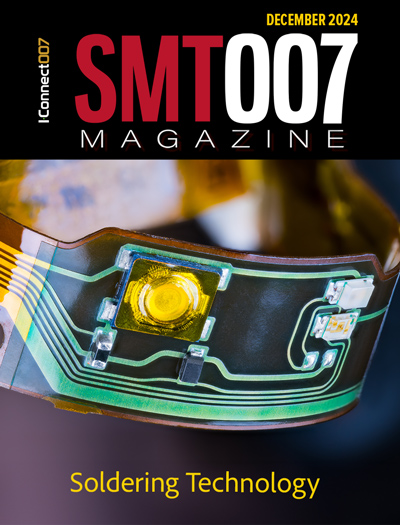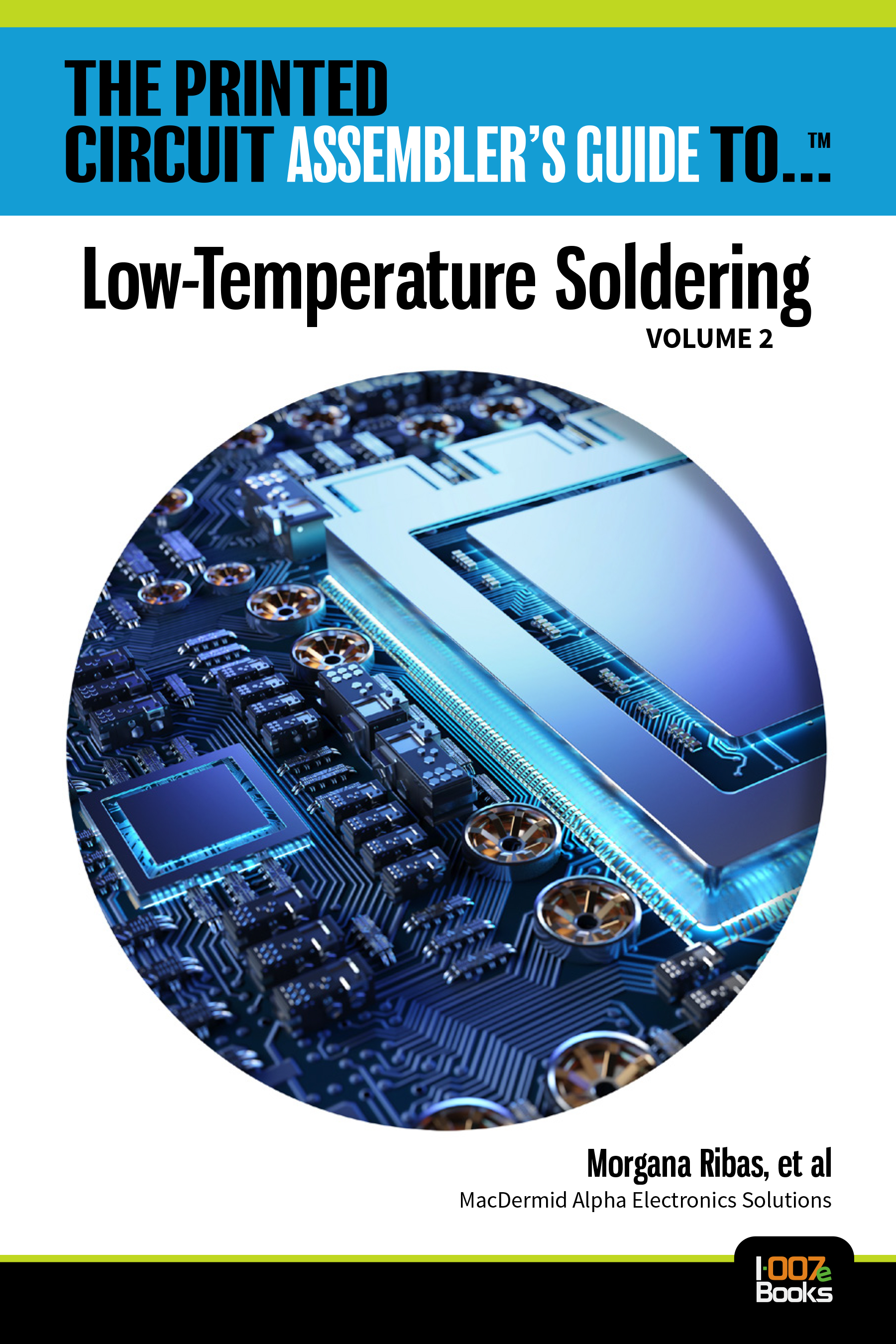-

- News
- Books
Featured Books
- smt007 Magazine
Latest Issues
Current Issue
Technical Resources
Key industry organizations–all with knowledge sharing as a part of their mission–share their technical repositories in this issue of SMT007 Magazine. Where can you find information critical to your work? Odds are, right here.

The Path Ahead
What are you paying the most attention to as we enter 2025? Find out what we learned when we asked that question. Join us as we explore five main themes in the new year.

Soldering Technologies
Soldering is the heartbeat of assembly, and new developments are taking place to match the rest of the innovation in electronics. There are tried-and-true technologies for soldering. But new challenges in packaging, materials, and sustainability may be putting this key step in flux.
- Articles
- Columns
Search Console
- Links
- Media kit
||| MENU - smt007 Magazine
The Benefits of Applying Flux Directly to a Micro BGA
May 12, 2017 | Richard Barratt, JJS ManufacturingEstimated reading time: 5 minutes
Technology trends continue to drive miniaturization in electronic components. As a result, product designers are often forced into specifying smaller and smaller devices on their bill of materials (BOM). Sometimes, miniature devices offer original equipment manufacturers (OEMs) cost savings, which is seen as a good thing; other times, there is simply no choice.
Component manufacturers continue to make devices obsolete in an attempt to release new technologies to market and keep up with consumer trends. This can be a problem for OEMs that have "old" versions of the part designed into their industrial hardware, as they may have to go through a redesign process.
Product designers are not always aware of the challenges redesigning their products to include miniature devices can cause. You could argue there is a disconnect between design and the manufacturing process. While electrically the new device may be fine, if it is located next to a much larger device then the electronics manufacturer may need to modify their build process and conduct additional trials to satisfy themselves they can consistently manufacture the product. All of which takes additional time and, in some cases, requires specialist equipment and tooling.
In this article, we share with you a case study featuring a printed circuit board assembly (PCBA) with a micro ball grid array (BGA) located next to a SIM card holder. We walk you through the process steps we took to ensure a consistent solder joint was made and share with you the results of the trials we conducted.
Unfortunately, we can’t tell you who the customer is. As with all our customers, we have a confidentially agreement in place but we can tell you they are a global security services company. We also can’t tell you much about the product either, sorry. But we can tell you that the PCBA is doubled sided, 8 up on a panel and includes a 0.4" pitch micro BGA (measuring 2.7mm x 2.4mm) located next to a SIM card reader measuring 26mm x 20mm, which is quite a difference.
Multi-level solder stencil
This presented us with a challenge. The micro BGA would require a solder paste height of 0.08mm compared to the SIM card reader that would need 0.125mm. The conventional way to approach this particular challenge and achieve varying solder paste heights is to specify a multi-level solder stencil. There are two common techniques (stepped and additive) in creating multi-level stencils, and if you would like to read more about the pros and cons of each, we recently wrote an article covering this topic.
Unfortunately, after using a stepped stencil we identified solder shorts and an approximate 25 percent failure rate on the micro BGA.
Left image: BGA with shorts. Right image: BGA without shorts.
Although we felt it possible to make further improvements to the stencil material and design (change to electro-formed nickel with a reduced solder deposit and nano coating), we wanted to minimize the risk of shorts completely and decided to look into applying flux to the micro BGA directly.
Direct flux application
We trialed Mycronic's dip unit as it attached to our pick and place surface mount equipment. The unit consists of a squeegee and flux transfer plate, which has several cavities at different depths cut into it. Flux is dispensed and the squeegee then wipes it across the cavities leaving them filled, after which the micro BGA is picked and dipped directly into them.
During our trials, we built two panels consisting of 16 micro BGAs in total. We trialed two different flux depths and ran one panel with 0.1mm and the other with 0.14mm, with the aim of covering at least 50 per cent of the ball height (0.2mm) with flux. Too much flux can result in the part sticking in the cavity. There is also a danger that when it reflows the gaps between the balls become filled with flux residue which can be a problem if you need to make the joint stronger by underfilling with resin.
After the devices had been fitted to the board and reflowed, we re-inspected the boards to look for potential issues.
The results
We inspected the panels using X-ray, no shorts were found and we saw good placement. Although X-ray images can provide confidence and offer a good level of detail, we always recommend several inspection methods when validating results.
Page 1 of 2
Suggested Items
Delvitech to Officially Present Hybrid AOI + SPI Horus System at IPC APEX EXPO 2025
02/06/2025 | DelvitechDelvitech is happy to announce that it will showcase its groundbreaking Horus system, the industry's first all-in-one AI native platform for both Automatic Optical Inspection (AOI) and Solder Paste Inspection (SPI), at the upcoming IPC APEX EXPO 2025. The event is scheduled from March 18 to 20, 2025, at the Anaheim Convention Center in Anaheim, California.
Dr. Jennie Hwang to Deliver Two PDCs at IPC APEX EXPO
02/04/2025 | Dr. Jennie HwangDr. Jennie Hwang, chair of the AI Committee of National Academies/DoD AI study, Chair of National AI Institute of NSF, and Committee of Strategic Thinking for Engineering Research in the Era of Artificial Intelligence of NSF, brings broad-based information and insights through an integrated perspective to the AI course.
TopLine Bringing Answers, New Ideas to APEX 2025
02/04/2025 | TopLineTopLine® Corporation’s engineers will discuss groundbreaking technologies and product solutions at the upcoming IPC APEX EXPO 2025 this coming March 18-20 at the Anaheim Convention Center in California.
Solderstar to Present Advanced Profiling Solutions at IPC APEX EXPO 2025
02/04/2025 | SolderStarSolderstar, a leading provider of profiling solutions for the electronics manufacturing industry, will exhibit at IPC APEX EXPO 2025, which will take place March 18-20, 2025, at the Anaheim Convention Center in California.
Rehm Thermal Systems: Future Technologies for Coating, Dispensing and Vapour Phase Soldering Live at IPC APEX EXPO 2025
02/04/2025 | Rehm Thermal SystemsIPC APEX EXPO 2024, which takes place from 18 to 20 March at the Anaheim Convention Center in California, is the largest and most important trade fair for electronics manufacturing in North America.


